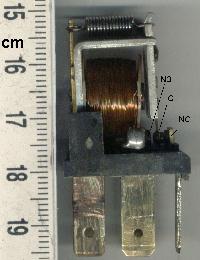
Back ميكانيكا كهربائية Arabic Elektromexanika Azerbaijani Electromecànica Catalan ئەلکترۆمکانیک CKB Elektromekanik Danish Elektromechanik German Elektromekaniko Esperanto Electromecánica Spanish Elektromehaanika Estonian الکترومکانیک Persian

Electromechanics[1][2][3][4] combines processes and procedures drawn from electrical engineering and mechanical engineering. Electromechanics focuses on the interaction of electrical and mechanical systems as a whole and how the two systems interact with each other. This process is especially prominent in systems such as those of DC or AC rotating electrical machines which can be designed and operated to generate power from a mechanical process (generator) or used to power a mechanical effect (motor). Electrical engineering in this context also encompasses electronics engineering.
Electromechanical devices are ones which have both electrical and mechanical processes. Strictly speaking, a manually operated switch is an electromechanical component due to the mechanical movement causing an electrical output. Though this is true, the term is usually understood to refer to devices which involve an electrical signal to create mechanical movement, or vice versa mechanical movement to create an electric signal. Often involving electromagnetic principles such as in relays, which allow a voltage or current to control another, usually isolated circuit voltage or current by mechanically switching sets of contacts, and solenoids, by which a voltage can actuate a moving linkage as in solenoid valves.
Before the development of modern electronics, electromechanical devices were widely used in complicated subsystems of parts, including electric typewriters, teleprinters, clocks, initial television systems, and the very early electromechanical digital computers. Solid-state electronics have replaced electromechanics in many applications.
- ^ Course in Electro-mechanics, for Students in Electrical Engineering, 1st Term of 3d Year, Columbia University, Adapted from Prof. F.E. Nipher's "Electricity and Magnetism". By Fitzhugh Townsend. 1901.
- ^ Szolc, T.; Konowrocki, Robert; Michajłow, M.; Pregowska, A. (2014). "An investigation of the dynamic electromechanical coupling effects in machine drive systems driven by asynchronous motors". Mechanical Systems and Signal Processing. 49 (1–2). Mechanical Systems and Signal Processing, Vol.49, pp.118-134: 118–134. Bibcode:2014MSSP...49..118S. doi:10.1016/j.ymssp.2014.04.004.
- ^ The Elements of Electricity, "Part V. Electro-Mechanics[permanent dead link]." By Wirt Robinson. John Wiley & sons, Incorporated, 1922.
- ^ Konowrocki, Robert; Szolc, T.; Pochanke, A.; Pregowska, A. (2016). "An influence of the stepping motor control and friction models on precise positioning of the complex mechanical system". Mechanical Systems and Signal Processing. 70–71. Mechanical Systems and Signal Processing, Vol.70-71, pp.397-413: 397–413. Bibcode:2016MSSP...70..397K. doi:10.1016/j.ymssp.2015.09.030. ISSN 0888-3270.